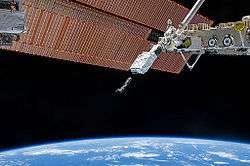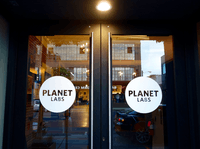Planet Labs
 | |
| Private | |
| Industry | |
| Founded | December 29, 2010[1][2] |
| Founder | Will Marshall, Chris Boshuizen, Robbie Schingler[1][2] |
| Headquarters | San Francisco, CA, U.S.[2] |
Number of locations | 4 offices (USA,Germany,Netherlands,Canada)[2] |
Area served | Worldwide |
Key people |
Will Marshall (CEO) Robbie Schingler (President) Tom Barton (COO) [1] |
| Products | "Dove" imaging satellites |
| Services | Satellite-based Earth imaging and analytics |
Number of employees | 101-250 (as of September 2015)[2] |
| Website |
planet |
Planet Labs, Inc. (formerly Cosmogia, Inc.) is an American Earth imaging private company based in San Francisco, CA.[1][2] The company designs and manufactures Triple-CubeSat miniature satellites called Doves that are then delivered into orbit as passengers on other missions. Each Dove Earth observation satellite continuously scans Earth, sending data once it passes over a ground station. Together, Doves form a satellite constellation that provides a complete image of Earth at 3-5 m optical resolution and open data access. Small size and a relatively low cost enable the company to quickly prototype and test new designs, while avoiding a loss of significant assets in a disaster. The images gathered by Doves provide up-to-date information relevant to climate monitoring, crop yield prediction, urban planning, and disaster response.[1] With acquisition of BlackBridge in July 2015, Planet Labs had 87 Dove and 5 RapidEye satellites in orbit.[3]
History

Planet Labs was founded in 2010 as Cosmogia by former NASA scientists Chris Boshuizen, Will Marshall, and Robbie Schingler.[4][5][6]
It successfully launched two demonstration CubeSats, Dove 1 and Dove 2, in April 2013.[7] Dove 3 and Dove 4 were launched in November 2013.[5]
In June 2013, it announced plans for Flock-1, a constellation of 28 Earth-observing satellites.[7]
The Flock-1 CubeSats were brought to the International Space Station in January 2014[8] and successfully deployed via the NanoRacks CubeSat Deployer in mid-February.[9] The company plans to launch a total of 131 satellites by mid-2015.[10]
In March 2014 co-founder and CEO Will Marshall presented at the TED conference in Vancouver.[11] In January 2015, the firm raised $95 million in funding.[12] As of May 2015, Planet Labs raised a total amount of $183 million in venture capital financing.[13]
In July 2015, Planet Labs acquired BlackBridge and its RapidEye constellation.[14]
Satellite constellation



Flock-1 satellites are CubeSats that weigh 4 kg (1000 times lower than legacy commercial imaging satellites), 10x10x30 cm in length, width and height,[15] orbit at a height of about 400 kilometres (250 mi) and provide imagery with a resolution of 3–5 m (9.8–16.4 ft) and envisaged environmental, humanitarian, and business applications.[16][17]
The twenty Flock 2e' 3U CubeSats[18] were launched in 23 March 2016 on the Cygnus CRS OA-6 cargo mission.[19]
Twelve Flock-2p Dove satellites each of which weighs just 4.7 kg were launched by ISRO (Indian Space Research Organization) on 22nd June 2016. The PSLV-C34 that carried the 12 Dove satellites lifted off from India's spaceport Sriharikota at 9:25 IST.[20][21]
See also
- Earth observation satellite
- Robotic spacecraft
- Spacecraft design
- CubeSat
- RapidEye
- Terra Bella
- SpaceX
- Oriondata Internacional: reseller of PlanetScope and Rapideye images in Chile and others countries in Latin America
External links
- Planet Labs website
- Keynote presentation "Reimagine Change From Space: Using Satellites To Image The Entire Planet" by the Planet Labs co-founder and CEO Will Marshall at the Salesforce.com's "Dreamforce" conference on 15 September 2015.
- Planet Labs on NASA TV (10 November 2015).
References
- 1 2 3 4 5 "Planet Labs website". Planet.com. Retrieved September 23, 2015.
- 1 2 3 4 5 6 "Crunchbase profile of Planet Labs". Crunchbase.com. 2015. Retrieved September 23, 2015.
- ↑ Tepper, Fitz (15 July 2015). "Satellite Maker Planet Labs Acquires BlackBridge's Geospatial Business". TechCrunch.com. Retrieved 28 September 2015.
- ↑ Brewster, Signe. "With plans to launch 28 satellites next year, at Planet Labs, the space industry is back", gigaom.com, 2 August 2013. Retrieved on 18 September 2013.
- 1 2 Graham, William. "Russian Dnepr conducts record breaking 32 satellite haul", nasaspaceflight.com, 21 November 2013. Retrieved on 26 November 2013.
- ↑ Solon, Olivia. "In pictures: Planet Labs' nanosatellites", Wired, 13 August 2013. Retrieved on 26 November 2013.
- 1 2 Wall, Mike. "Planet Labs Unveils Tiny Earth-Observation Satellite Family", space.com, 31 August 2013. Retrieved on 18 September 2013.
- ↑ Wall, Mike. "Record-Breaking 33 'Cubesats' to Launch from Space Station This Month", space.com, 4 February 2014. Retrieved on 6 February 2014.
- ↑ Klotz, Irene. "Satellite 'Flock' Launched From ISS Cubesat Cannon: Photos", discovery.com, 18 February 2014, Retrieved on 25 April 2014.
- ↑ Taylor, Richard. "Mini-satellites send high-definition views of Earth", BBC, 15 May 2014. Retrieved on 16 May 2014.
- ↑ Marshall, Will (2014-03-19). "Tiny satellites show us the Earth as it changes in near-real-time". New York, NY: TED Talks. Retrieved 2014-12-23.
- ↑ Reuters (20 January 2015). "SpaceX raises $1 billion in funding from Google, Fidelity". NewsDaily.
- ↑ Sarah Buhr. "Planet Labs Rockets To $118 Million In Series C Funding To Cover The Earth In Tiny Satellites". TechCrunch. AOL.
- ↑ Foust, Jeff (2015-07-15). "Planet Labs Buying BlackBridge and its RapidEye Constellation". Space News. Retrieved 16 July 2015.
- ↑ Will Marshall: Tiny satellites that photograph the entire planet, every day. YouTube. 18 November 2014.
- ↑ Werner, Debra. "With 2 More Cubesats in Orbit, Earth-imaging Startup Planet Labs Ships Next Batch of 28 to Wallops", spacenews.com, 26 November 2013. Retrieved on 26 November 2013.
- ↑ Bradshaw, Tim. "US start-up to launch record number of satellites", ft.com, 26 November 2013. Retrieved on 26 November 2013.
- ↑ Krebs, Gunter Dirk (16 January 2016). "The Flock Earth observing constellation". Gunter's Space Page. Retrieved 2016-01-22.
- ↑ Graham, William (March 22, 2016). "OA-6 Cygnus launched to the ISS via Atlas V". NASA Spaceflight. Retrieved 2016-03-27.
- ↑ 10 things to know about ISRO's 20 satellites mission Times of India 22 June 2016
- ↑ Flock-1 Gunther's Space Page 22 June 2016